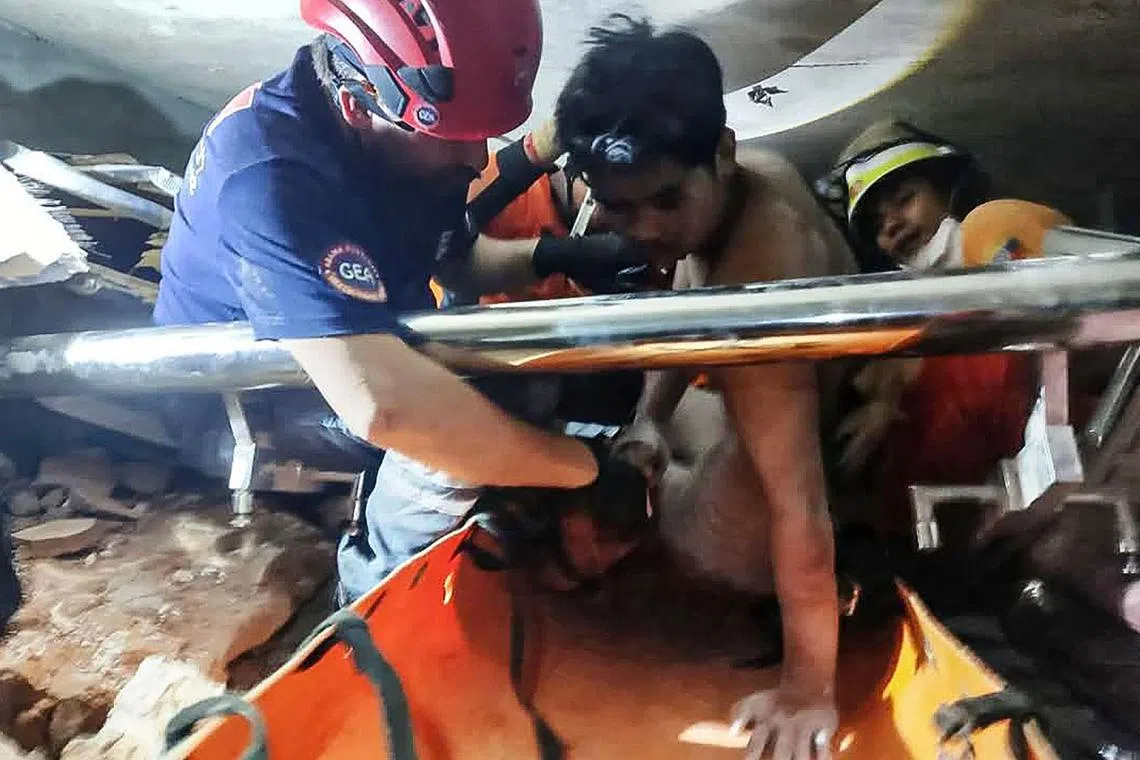Myanmar quake survivors plead for more help
Sign up now: Get ST's newsletters delivered to your inbox

A 26-year-old hotel worker was extracted by a joint Myanmar-Turkish team in Naypyitaw shortly after midnight on April 2.
PHOTO: AFP
Follow topic:
MANDALAY – Desperate Myanmar earthquake survivors pleaded for more aid on April 2 as the death toll rose and calls grew for the junta to halt attacks on rebels as the country battles the crisis.
The shallow 7.7-magnitude earthquake on March 28
Several leading armed groups fighting the military have suspended hostilities during the quake recovery.
The junta, after saying earlier that military operations would continue despite international criticism of multiple reported air strikes, announced a brief ceasefire on April 2.
AFP journalists saw chaotic scenes as at least 200 desperate people lined up for aid distribution in Sagaing, the city closest to the epicentre of the quake, some running through traffic to join the queues.
Destruction in the city is widespread, with the World Health Organisation (WHO) reporting that one in three houses had collapsed. Five days after the quake, locals complained of a lack of help.
“Of course, we don’t have enough,” said Ms Ayethi Kar, 63, head of a school for young nuns that was destroyed by the tremors. “Now we eat donated food and water but we sleep on the ground.”
Healthcare facilities, damaged by the quake and with limited capacity, are “overwhelmed by a large number of patients”, while supplies of food, water and medicine are running low, WHO said in its latest update on April 1.
Hopes of finding more survivors are fading, but there were moments of joy on April 2 as two men were pulled alive from the ruins of a hotel in the capital Naypyitaw.
Call for peace
The junta said on April 2 that the death toll had risen to 2,886, with more than 4,600 injured and 373 still missing.
But with patchy communication and infrastructure delaying efforts to gather information and deliver aid, the true scale of the disaster has yet to become clear, and the toll is likely to rise.
Relief groups say the overall quake response has been hindered by continued fighting between the junta and the complex patchwork of armed groups opposed to its rule, which began after the military seized power in a 2021 coup.
Ms Julie Bishop, the UN special envoy on Myanmar, called on all sides to “focus their efforts on the protection of civilians, including aid workers, and the delivery of life-saving assistance”.
Even before the March 28 earthquake, 3.5 million people had been displaced by the fighting, with many of them at risk of hunger, according to the United Nations.
Late on April 1, an alliance of three of Myanmar’s most powerful ethnic minority armed groups announced a one-month pause in hostilities to support humanitarian efforts in response to the quake.
The announcement by the Three Brotherhood Alliance followed a separate partial ceasefire called by the People’s Defence Force – civilian groups that took up arms after the coup to fight junta rule.
There have been multiple reports of junta air strikes against rebel groups since the quake. But on April 2, state-run MRTV reported that the military has announced a temporary ceasefire effective from April 2 to 22 to facilitate rehabilitation of the country after the disaster.
The move comes as Senior General Min Aung Hlaing prepares to attend a regional summit of mostly South Asian leaders in Bangkok this week.
A junta spokesman said soldiers fired warning shots on April 1 when a Chinese Red Cross convoy failed to stop while approaching a village in conflict-ridden Shan state to deliver aid to earthquake victims.
The UN special rapporteur on human rights in Myanmar, Mr Tom Andrews, rejected the junta’s characterisation of its operations.
“Senior General Min Aung Hlaing has described ongoing junta attacks in the midst of Myanmar’s suffering as ‘necessary protective measures’,” he wrote on X.
“They are neither necessary nor protective. They are outrageous and should be condemned in the strongest possible terms by world leaders.”
Thailand toll rises
Australia’s government decried the reported air strikes, saying they “exacerbated the suffering of the people”.
Amnesty International said “inhumane” military attacks were significantly complicating earthquake relief efforts in Myanmar.
“You cannot ask for aid with one hand and bomb with the other,” said the group’s Myanmar researcher Joe Freeman.
Hundreds of kilometres away, in the Thai capital Bangkok, workers continued to scour the remnants of a 30-storey skyscraper that was still being built when it collapsed on March 28.
The death toll at the site has risen to 22, with more than 70 still believed trapped in the rubble. AFP

